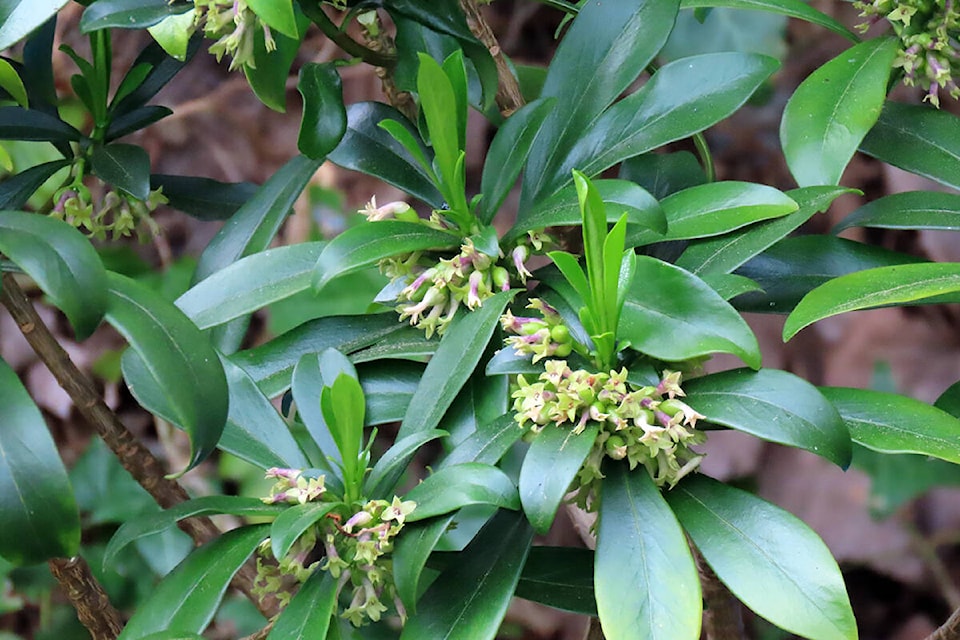Pat wrote in to inform us an invasive, toxic plant has been rediscovered in their garden. It had been removed several years ago but has reappeared. The villain is spurge-laurel, or to be botanically correct – Daphne laureola.
Unfortunately, it is not just in their garden but has also been spotted on the outer edges of the Comox Golf Club course. Pat says she has seen evidence of this plant along Balmoral, Stewart, Robb, Church, Centennial, Queens and Buena Vista as well. We are definitely not talking about just one plant here.
To assist in identifying this plant… Daphne laureola is an evergreen perennial shrub which grows between 0.5 and 1.5 metres (1.5 – 5 feet) tall, depending on the type of soil in your garden. The volunteer daphne that appeared in our garden never grew taller than about four feet as it was in a small concrete bed already chock-full of lily of the valley – another poisonous plant.
The oblanceolate leaves on this daphne species are glossy dark green above and light green underneath. They form in whorled tuffs at the ends of the pale brown branches which themselves are soft, often prostrate for a section before pulling themselves upright. Clusters of pale green flowers appear in spring, nestled among the base of the leaves at the tips of all branches, providing nectar for bees. Later, blue-black berries form – a treat for some small mammals and birds, particularly robins and cedar waxwings.
The preferred location in the garden is shade or partial shade and since it does not grow overly tall, it resides nicely under tall trees such as stately conifers.
The earliest record of a Daphne laureola being introduced as an ornamental outside of its native region predates the 1780s when a specimen was planted in a Welsh garden. From there it progressed into gardens throughout Britain and in North America. B.C. received its first Daphne laureola in 1968 where it was given pride of place in the garden surrounding Government House in Victoria. Herbarium records note more daphnes were planted in the Metchosin area, specifically around Taylor Beach, in 1973.
Fast forward to the present day, spurge-laurel has now naturalized in Victoria, northward to Campbell River, throughout the Lower Mainland, along the Pacific coast and the Gulf Islands.
Honestly, there are many introduced plant species which have escaped their original garden placement into the wilds of B.C. and beyond. Himalayan blackberry (Rubus armeniacus) and English ivy (Hedera helix) are just two which come to mind. They, along with the spurge-laurel, are out-competing many of our smaller native plant species.
To date, the Invasive Council of BC has designated Daphne laureola as a “management” species on the BC Provincial Priority Invasive Species List. But Pat mentioned in her letter that it is “listed as a poisonous plant by the Canadian Poisonous Plants Information System.” Worksafe BC lists it as toxic.
You are forewarned. Long sleeves, gloves and goggles are recommended attire for plant removal as the sap can cause skin irritation and you want to protect your eyes. Also, watch your child does not eat any daphne berries. As few as two berries can be lethal to a child.
Everyone should exercise caution around toxic plants but you might be interested to learn there are potential benefits to some of the compounds found in five daphne species, including Daphne laureola. There is hope for new breakthroughs in the treatment of lung and breast cancers. That would make spurge-laurel a good plant on my list.
To read more about this plant – both good and bad – visit my website: duchessofdirt.ca.
Leslie Cox co-owns Growing Concern Cottage Garden in Black Creek.
